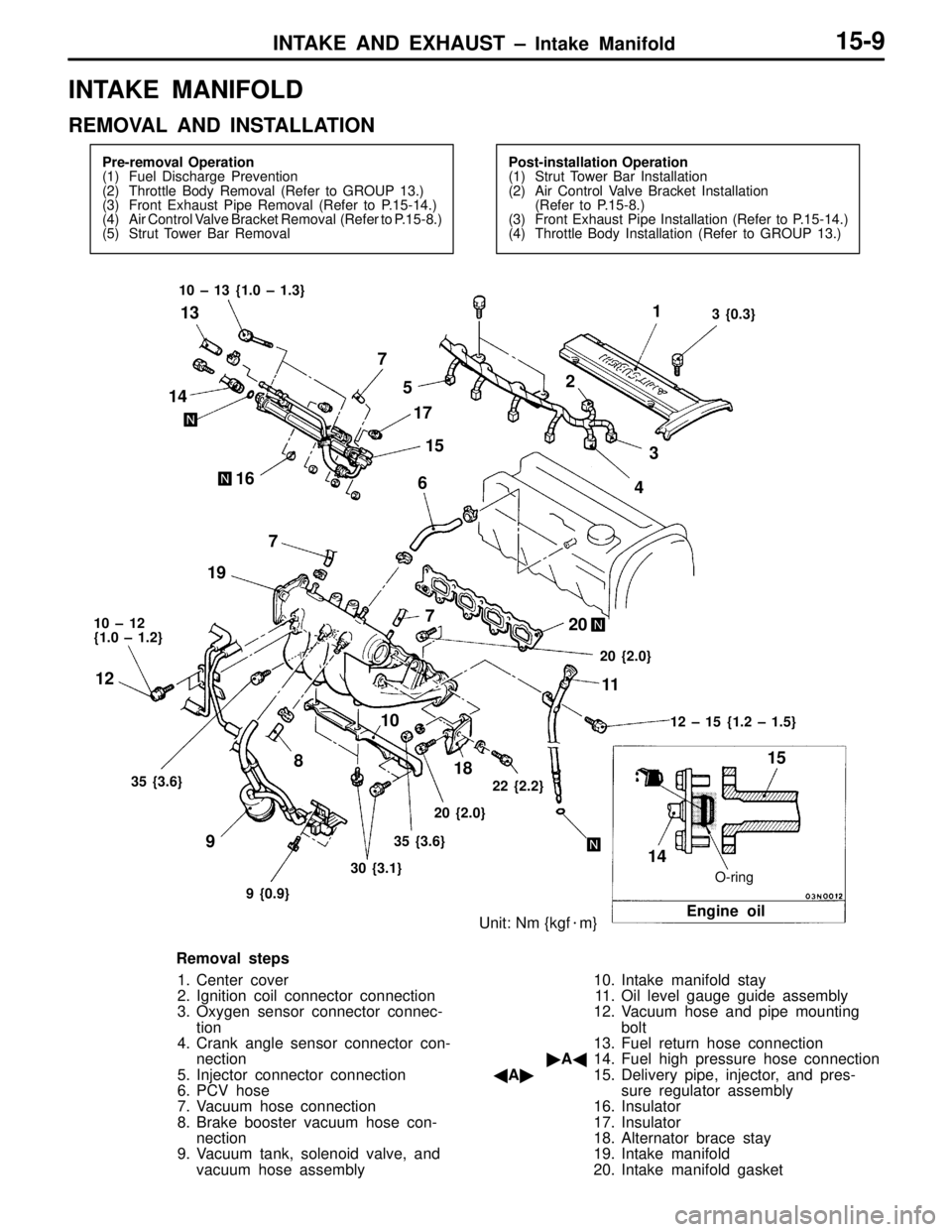Page 79 of 396
MPI – Injector13-36
INJECTOR
REMOVAL AND INSTALLATION
Pre-removal Operation
(1) Fuel Discharge Prevention
(2) Air Hose D Removal
(Refer to GROUP15 – Intercooler.)Post-installation Operation
(1) Air Hose D Installation
(Refer to GROUP15 – Intercooler.)
(2) Fuel Leakage Check
O-ring
9 {0.9}83, 6
11
12
O-ring 10 – 13 {1.0 – 1.3}
Engine oil
1
2 3
4
5
6 78 9
10 11 12
Unit: Nm {kgf�m}
4
Removal steps
1. Injector connector
2. PCV hose connection
�A�3. High-pressure fuel hose connection
4. Fuel return hose connection
5. Vacuum hose connector
�A�6. Fuel pressure regulator7. Fuel return pipe
�A�8. Delivery pipe
9. Insulator
10. Insulator
�A��A�11. Injector
12. Grommet
Page 84 of 396

ENGINE COOLING – Thermostat14-4
INSTALLATION SERVICE POINTS
�A�THERMOSTAT INSTALLATION
(1) Install the thermostat so that the jiggle valve is facing
straight up.
Caution
Make absolutely sure that no oil is adhering to the
rubber ring of the thermostat. If the rubber ring is
damaged, replace the thermostat.
(2) When assembling the thermostat, be careful not to fold
over or scratch the rubber ring.
�B�RADIATOR LOWER HOSE CONNECTION
(1) Insert each hose as far as the projection of the water
inlet fitting.
(2) Align the mating marks on the radiator hose and hose
clamp, and then connect the radiator hose.
INSPECTION
THERMOSTAT CHECK
(1) Immerse the thermostat in water, and heat the water while
stirring. Check the thermostat valve opening temperature.
Standard value: 76.5 ± 1.5�C
(2) Check that the amount of valve lift is at the standard
value when the water is at the full-opening temperature.
Standard value:
Full-opening temperature: 90�C
Amount of valve lift: 8.5 mm or more
NOTE
Measure the valve height when the thermostat is fully
closed, calculate the valve lift by subtracting this
measurement from the valve height when the thermostat
is fully open.
Jiggle valve
Rubber ring
Valve lift
Page 91 of 396

INTAKE AND EXHAUST –
Service Specifications /
Special Tool / On-vehicle Service15-2
SERVICE SPECIFICATIONS
ItemsStandard valueLimit
Turbocharger boost pressure kPa {kg/cm2}53 – 87 {0.54 – 0.89}–
Wastegate actuator activation pressure kPa {kg/cm2}Approx. 100 {1.02}–
Wastegate solenoid valve coil resistance (at 20�C) Ω62 – 74–
Air bypass valve activation pressure kPa {mmHg}Approx. 53 {400}–
Secondary air control solenoid valve coil resistance (at 20�C) Ω28 – 36–
Intake manifold and exhaust manifold mounting surface distortion
mmWithin 0.150.20
SPECIAL TOOL
ToolNumberNameApplication
MB998770Oxygen sensor
wrenchRemoval and installation of oxygen sensor
ON-VEHICLE SERVICE
1. TURBOCHARGER BOOST PRESSURE
CHECK
Caution
Carry out driving tests in a location where full-throttle
acceleration is possible with utmost safety. Two persons
should be in the vehicle during the test, the assistant
in the front passenger seat reading the pressure gauge.
(1) Disconnect the hose (black) from the boost pressure
control solenoid valve and fit the pressure gauge to this
hose.
After the hose (black) has been disconnected, fit a blank
plug to the solenoid valve nipple.
(2) Drive at full-throttle acceleration in second gear and
measure the boost pressure when the engine speed
exceeds about 3,000 r/min.
Standard value:
53 – 87 kPa {0.54 – 0.89 kg/cm
2}
59 – 84 kPa {0.61 – 0.86 kg/cm2}
Wastegate
solenoid valve
Blank plug
Page 94 of 396

INTAKE AND EXHAUST – On-vehicle Service15-5
6. SECONDARY AIR CONTROL SYSTEM
CHECK
(1) Start the engine and let it run at idle speed.
(2) Short-circuit the no. 6 terminal of the engine ECU
connector using a jumper wire and check at this time
that the secondary air valve lifts.
At this time, the engine ECU connector should be
connected.
7. SECONDARY AIR CONTROL SOLENOID
VALVE CHECK
7-1 OPERATION CHECK
(1) Disconnect the vacuum hose (white stripe, yellow stripe)
from the solenoid valve.
(2) Disconnect the harness connector.
(3) Connect a hand vacuum pump to nipple A of the solenoid
valve.
(4) Using jumper wires, connect the solenoid valve terminal
to battery terminals.
(5) Disconnecting and reconnecting the jumper wire on the
(–) terminal side, apply vacuum to check for airtightness.
Jumper wireNipple B conditionNormally
ConnectedOpenVacuum leaks.
PluggedVacuum retained.
DisconnectedOpenVacuum leaks.
7-2 COIL RESISTANCE CHECK
Measure the resistance across solenoid valve terminals.
Standard value: 28 – 36 Ω (at 20�C)
Secondary air control
solenoid valve
Battery
Page 98 of 396

INTAKE AND EXHAUST – Intake Manifold15-9
INTAKE MANIFOLD
REMOVAL AND INSTALLATION
Pre-removal Operation
(1) Fuel Discharge Prevention
(2) Throttle Body Removal (Refer to GROUP 13.)
(3) Front Exhaust Pipe Removal (Refer to P.15-14.)
(4) Air Control Valve Bracket Removal (Refer to P.15-8.)
(5) Strut Tower Bar RemovalPost-installation Operation
(1) Strut Tower Bar Installation
(2) Air Control Valve Bracket Installation
(Refer to P.15-8.)
(3) Front Exhaust Pipe Installation (Refer to P.15-14.)
(4) Throttle Body Installation (Refer to GROUP 13.)
O-ring
Unit: Nm {kgf�m}
15
Engine oil
3 {0.3} 10 – 13 {1.0 – 1.3}
10 – 12
{1.0 – 1.2}
12 – 15 {1.2 – 1.5}
35 {3.6}
9 {0.9}30 {3.1}35 {3.6}20 {2.0}22 {2.2}20 {2.0}
14 14
167
5
17
1521
3
4 6
7 7
19
20
18 8
9 12
1011
13
Removal steps
1. Center cover
2. Ignition coil connector connection
3. Oxygen sensor connector connec-
tion
4. Crank angle sensor connector con-
nection
5. Injector connector connection
6. PCV hose
7. Vacuum hose connection
8. Brake booster vacuum hose con-
nection
9. Vacuum tank, solenoid valve, and
vacuum hose assembly10. Intake manifold stay
11. Oil level gauge guide assembly
12. Vacuum hose and pipe mounting
bolt
13. Fuel return hose connection
�A�14. Fuel high pressure hose connection
�A�15. Delivery pipe, injector, and pres-
sure regulator assembly
16. Insulator
17. Insulator
18. Alternator brace stay
19. Intake manifold
20. Intake manifold gasket
Page 99 of 396

INTAKE AND EXHAUST – Intake Manifold15-10
REMOVAL SERVICE POINT
�A�DELIVERY PIPE, INJECTOR AND PRESSURE
REGULATOR REMOVAL
Remove the delivery pipe with the injectors and pressure
regulator attached to it.
Caution
Care must be taken, when removing the delivery pipe,
not to drop the injector.
INSTALLATION SERVICE POINT
�A�HIGH-PRESSURE FUEL HOSE INSTALLATION
(1) When connecting the high-pressure fuel hose to the
delivery pipe, apply a small amount of new engine oil
to the O-ring and then insert the high-pressure fuel hose,
being careful not to damage the O-ring.
Caution
Be careful not to let any engine oil get into the delivery
pipe.
(2) Check to be sure that the high pressure hose turns
smoothly.
If it does not turn smoothly, the O-ring may be trapped.
Remove the high-pressure fuel hose to check for damaged
O-ring and then re-insert it into the delivery pipe and
check once again.
(3) Tighten the mounting bolts to the specification.
INSPECTION
INTAKE MANIFOLD CHECK
(1) Check the intake manifold for damage or cracking and
replace it if defective.
(2) Using a straight edge and feeler gauge, check for distortion
of the cylinder head installation surface.
Standard value: 0.15 mm or less
Limit: 0.2 mm
High-pressure
fuel hoseDelivery pipe
O-ring
Page 100 of 396

INTAKE AND EXHAUST – Exhaust Manifold and Turbocharger15-11
EXHAUST MANIFOLD AND TURBOCHARGER
REMOVAL AND INSTALLATION
Pre-removal and Post-installation Operation
(1) Radiator Removal and Installation
(Refer to GROUP 14.)
(2) Air Intake Hose and Air Hose A Removal and
Installation (Refer to P.15-7.)
(3) Front Exhaust Pipe Removal and Installation
(Refer to P.15-14.)(4) Air Pipe Assembly Removal and Installation
(Refer to P.15-8.)
(5) Engine Oil Removal and Refilling
1
Unit: Nm {kgf�m}
49 {5.0}54 – 64 {5.5 – 6.5}
9 {0.9} 12 – 15 {1.2 – 1.5}
23
4
29 {3.0}
20
49 – 59 {5.0 – 6.0}
54 – 64 {5.5 – 6.5}
30 {3.1} 17 – 20 {1.7 – 2.0}10 {1.0} 42 {4.2}10 {1.0} 10 – 12 {1.0 – 1.2} 17 {1.7} 49 {5.0}
27 – 32 {2.7 – 3.3}
19
6
10
12
10
11
18 7
8
9 171615 1413
5
Removal steps
1. Exhaust manifold heat protector
�A�2. Oxygen sensor
3. Turbocharger heat protector
4. Water pipe assembly A connection
5. Water hose connection
�B�6. Oil pipe
7. Starter
8. Oil return pipe
�C�9. Oil return pipe gasket
10. Vacuum hose connection11. Air outlet fitting
�B�12. Air outlet fitting gasket
13. Turbocharger gasket
14. Turbocharger assembly
�A�15. Turbocharger
16. Exhaust fitting gasket
17. Exhaust fitting
18. Water pipe hose assembly
19. Exhaust manifold
20. Exhaust manifold gasket
Page 101 of 396
INTAKE AND EXHAUST – Exhaust Manifold and Turbocharger15-12
REMOVAL SERVICE POINTS
�A�OXYGEN SENSOR REMOVAL
�B�OIL PIPE REMOVAL
Caution
After the oil pipe has been removed, ensure that no foreign
matter will get into the oil passage holes in turbocharger.
INSTALLATION SERVICE POINTS
�A�TURBOCHARGER INSTALLATION
(1) Clean the connections between oil pipe, oil return pipe,
and water pipe.
Caution
Ensure that no foreign matter will get into the
turbocharger.
(2) Through the oil pipe mounting hole in the turbocharger,
add fresh engine oil.
�B�AIR OUTLET FITTING GASKET INSTALLATION
Install the gasket so that its tab is located as shown.
MB998770
Turbocharger
Ta b